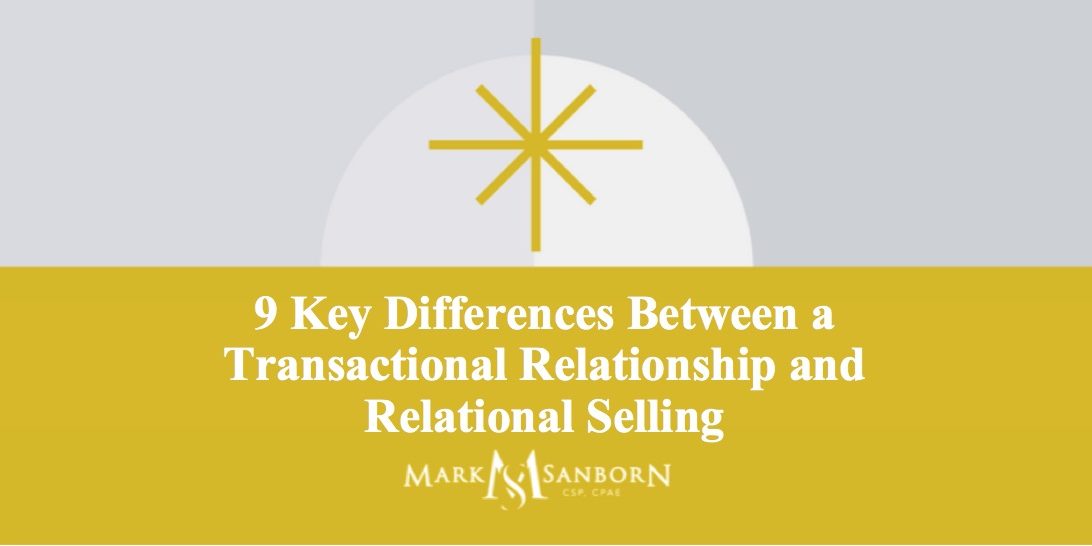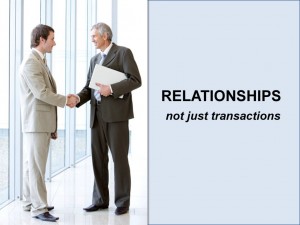Do you know the difference between a transactional relationship and relational selling?
Employers say they want employees to “build relationships” with customers and clients but often neither explain the differences nor teach employees how to do it.
In my book, The Fred Factor, I talk about how passion in both work and life can turn the ordinary into the extraordinary. This is how relational selling works.
Sometimes a transaction is sufficient, but simply building a transactional relationship is never a good long-term strategy for customer retention. We like and do business with companies that are relational.
You’ll notice transactional and relational differences in all areas of business, from marketing and sales, to customer service, and even in leadership styles within organizations. You’ll probably notice the differences in yourself in certain situations too.
Transactional vs Relational selling.
Both approaches to selling can be effective, but if you’re looking to go beyond just making a sale, and you want to retain customers and build strong relationships, then the focus must be on relational selling.
- A transactional relationship is all about the short-term. Get the sale, at all costs. The focus is on winning this one sale without much thought to the customer’s needs or the longer-term.
- Relational selling is about building long-term relationships. The sales rep gets to know their customer, their needs, and their wants, within reason.
Take the situation of a single mother needing a new washing machine. A transactional sale will involve getting her to buy a more expensive machine with bells and whistles that she doesn’t need and probably can’t afford.
The hard sell gets her to buy it anyway, and she leaves feeling stressed about how much money she just spent. She will likely never return to that store.
With relational selling, the salesperson would understand through talking to the customer that money is tight and instead sells her a brand new machine that was dented in delivery and therefore is on sale.
The customer is so grateful that she tells all of her friends about the store, makes a recommendation on social media, and goes back to the same store to get her dryer when it too needs replacing.
In today’s technology-driven world, an experience with a business, whether positive or negative, is no longer restricted to only word-of-mouth—it can be online for the world to see within minutes.
The rise of social media platforms means companies that operate only in a “transactional relationship”, rather than in “relational selling”, will be called out, and ultimately, companies and individuals who practice relational selling will experience higher levels of success than those who don’t.
This is a great way to achieve breakthrough success. I go into more detail about how to achieve this type of breakthrough success in my book, The Intention Imperative.
9 Key Differences Between a Transactional Relationship and Relational Selling
1. Professional vs. Friendly
2. Self-Interest vs. Mutual Interest
3. What You Get vs. What You Give
4. Stay in Touch vs. Keep Informed
5. Understand the Process vs. Understand the Person in the Process
6. Judge the Results vs. Evaluate the Relationship
7. Win Conflict vs. Resolve Conflict
8. Agreement vs. Acceptance
9. Evaluate the Results vs. Evaluate How the Other Feels About the Results
Consider the interactions you have with people in your life, as a leader, and as a person. You can learn how I can bring this message to your team through one of my many leadership keynote topics.
Are you building rewarding relationships or merely transacting your way through life?
To learn more about the importance of taking different approaches to sell, take a look at any of my wide collection of resources, which offer invaluable advice about building relationships, different approaches to selling, and being a successful leader. For tips on how to reinvent your day and center your life around your highest priorities, you can also consider reading my Extraordinary Living Journal – buy one, get one free!
If you enjoyed this post, here are three more articles you might also find interesting:
How to Deal with Increasing Customer Expectations
When to Fix and When to Fire
Think On the Known, Not Just the New
This post was originally published on February 25, 2013 and has been updated for 2019.










3 Comments